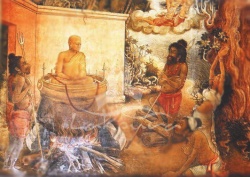Bodhisattvabhūmi
Bodhisattvabhūmi [-] stages of Bodhisattva practice. Bodhisattvabhūmi-s are different stages of spiritual progress through which a Bodhisattva passes from the stages of stream-enterer to the final attainment, that is, Buddhahood. They are prescribed for a Bodhisattva when he is tantamount to a Buddha. After practicing them he becomes a samyak sambuddha. The ten stages (daśabhūmi-s) are important from the point of view of spiritual advancement. They are introduced in an ascending order. They can be called as the mile stones in the pilgrimage of a Bodhisattva. Though all perfections are practised in all stages, the pāramitā that predominates a particular stage is linked with that stage. The enumerations of the ten stages are symbolic in nature and are found variously. The Mahāyānasūtrālaṃkāra describes them as follows.
(1) Muditā -- joy, delight. In this stage the aspirant rejoices in the realization of partial aspect of truth. He is possessed of joy because he has cherished the goal of enlightenment, renounced all worldly wealth, and offered himself to practice of perfections as well as to the service of others.
(2) Vimalā -- purity, freedom from defilements. In this stage through the practice of śīla pāramitā the Bodhisattva becomes pure in morality of speech and conduct. He abandons the akuśala karma-s. This stage resembles the stages of srotāpanna and sakṛdāgāmī of the Theravādin-s.
(3) Prabhākarī -- emission of light. The Bodhisattva becomes effulgent due to his realization of the truths of impermanence and no-self, and through his resolve to save others from suffering, which is a result of practicing four meditations and mystic trances.
(4) Arciṣmatī -- glowing. In this stage flame of wisdom burns mundane desires. All elements of evil and illusion are consumed through the practice of thirty-seven allies of enlightenment (bodhipākṣika- dharma-s].
(5) Durjayā -- difficult to conquer, invincibility, overcoming difficulties. In this stage the illusion of ignorance is overcome. The Bodhisattva realises that all formations (saṃskāra-s) are empty. He attains the knowledge of the Four Noble Truths. He considers the absolute and relative knowledge as one.
(6) Abhimukhī -- facing forward, revealing oneself, sign of supreme wisdom. In this stage supreme wisdom begins to appear because the Bodhisattva acquires the knowledge of the Dependent Origination. He reflects on the essence of dharma-s and realises the truth. He practises the wisdom perfection and forms an attitude of compassion towards those who wander in saṃsāra.
(7) Dūraṅgamā -- hard to measure, far reaching. The Dūraṅgamābhūmi transcends the two vehicles. In this stage the Bodhisattva has practiced ten perfections, four saṃgrahavastu-s namely truth, renunciation, tranquillity and wisdom. He engages himself in the practice of the skilful means (upāyakauśalya) to attain the goal. He ceaselessly contemplates on emptiness, signlessness and aimlessness, the three aspects of Nirvāṇa. Though he himself has reached the highest sphere of spirituality, he does not hesitate to practice rites and rituals for the sake of common people.
(8) Acalā -- becoming immovable, immovability. Becoming immovable (acalā-bhūmi) means abiding in the truth of the middle way and so being unperturbed. When he knows that everything partakes of suchness (tathatā) the Bodhisattva reaches a stage from which he does not retrogress. In this stage actions are spontaneous and innocent, they can be described as a sport. Whatever he wills, is done.
(9) Sādhumatī -- possessing goodness, preaching of dharma, all penetrating wisdom. In this stage the enlightened teaches the doctrine in order to benefit the sentient beings. He has the knowledge of disciples, of the self-enlightened, the Bodhisattva-s and of the Tathāgata. He possesses the four pratisaṃvid-s four pratisaṃvid-s, namely, knowledge of dharma, of its meaning, expression, and presence of mind. Hence he is capable of teaching the doctrine to people.
(10) Dharmameghā Dharma-cloud. All sentient beings are benefitted without discrimination just as a cloud rains on all things without distinction. In this stage the enlightened one personifies love, sympathy and compassion. Whatever he does, benefits all living-beings. He becomes omniscient and pours the nectar of dharma on all. Thousands of rays emitting from the body of the Tathāgata-s as though shower coronation on him as samyak saṃbuddha. Hence this stage is also known as abhiṣeka-bhūmi. The Vimalā stage resembles the srotāpanna and sakṛdāgāmī stages of the Theravādin-s. The Prabhākarī, Arciṣmatī, Durjayā, Abhimukhī resemble the stage of an Arhat. The Dūraṅgamā, Acalā, Sādhumatī, and Dharmameghā pertain to the Mahāyāna alone. The eighth stage acalā is endowed with an element of mysticism. The element is also reflected in other stages. The Mahāvastu contains a different enumeration. According to the Mahāvastu, the ten stages are: difficult to enter, (Durārohā), fastening (Baddhamānā), adorned with flowers (Puṣpamaṇḍitā), beautiful (Rucirā), expansion of the heart (Cittavistarā), lovely (Rūpavatī), difficult to conquer (Durjayā), ascertainment of birth (Janmanideśa), installation as crown prince (Yauvarājya) and coronation (Abhiṣeka). One more list comprises the following stages: setting the mind towards enlightenment, beginner, practitioner, born in a high family, perfection of means, endowed with virtues in previous births, absence of moral fall, becoming a prince, installation as crown prince and anointment as Buddha-the king. The Prajñāpāramitā Sūtra enlists the following stages: the stage of dry knowledge; of noble race; of stream- enterer; of right view; of diminishing defilements; elimination of all defilements in the realm of desire; elimination of all defilements in the kāma, rūpa and arūpaloka; the pratyekabuddha stage; the bodhisattva stage, and Buddha stage.
The term bhūmi also denotes 52 levels of Bodhisattva practice.
Page: The Flower Ornament Scripture. XV. 394-400. Mahāyāna-Sūtrālaṅkāra. XX-XXI. 173-175.


